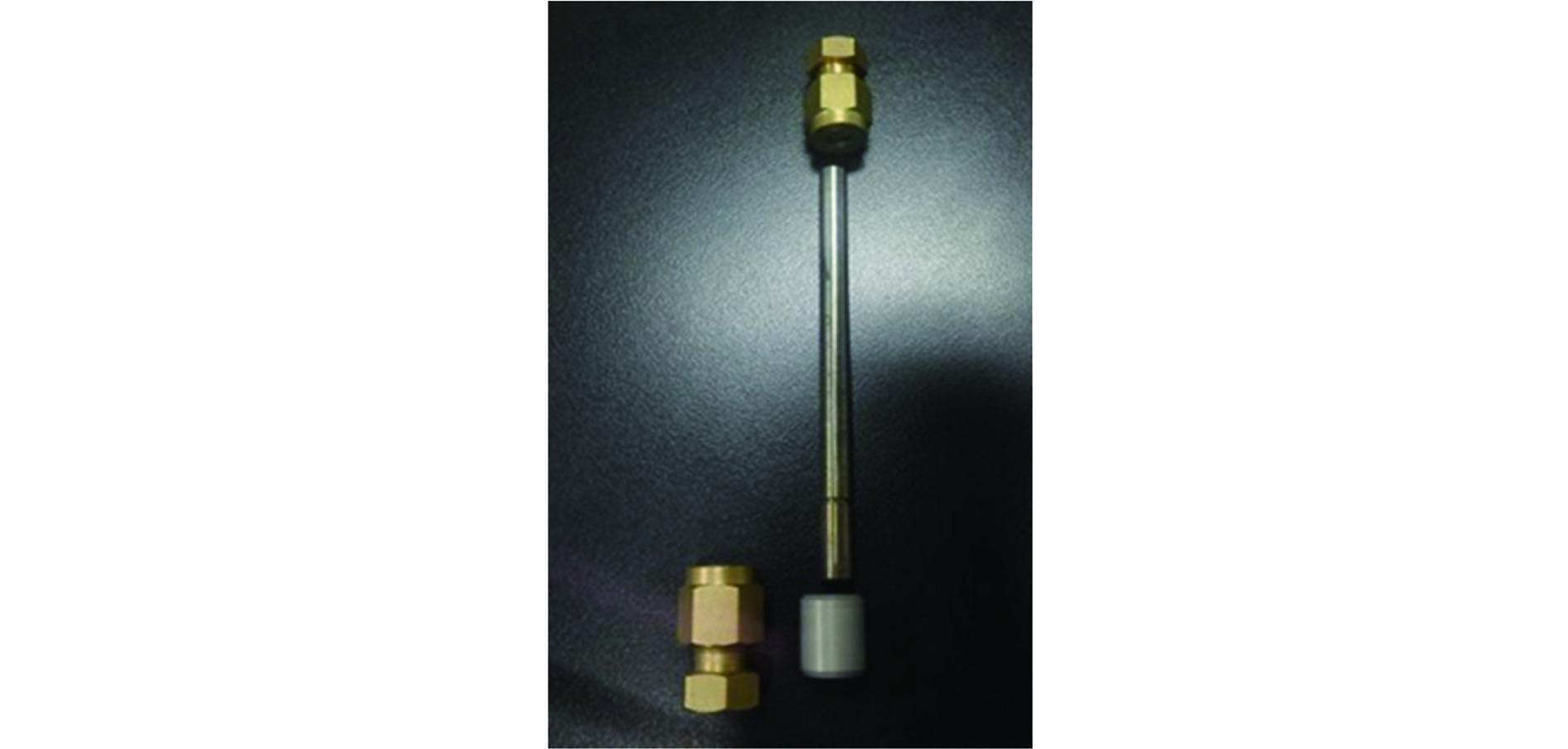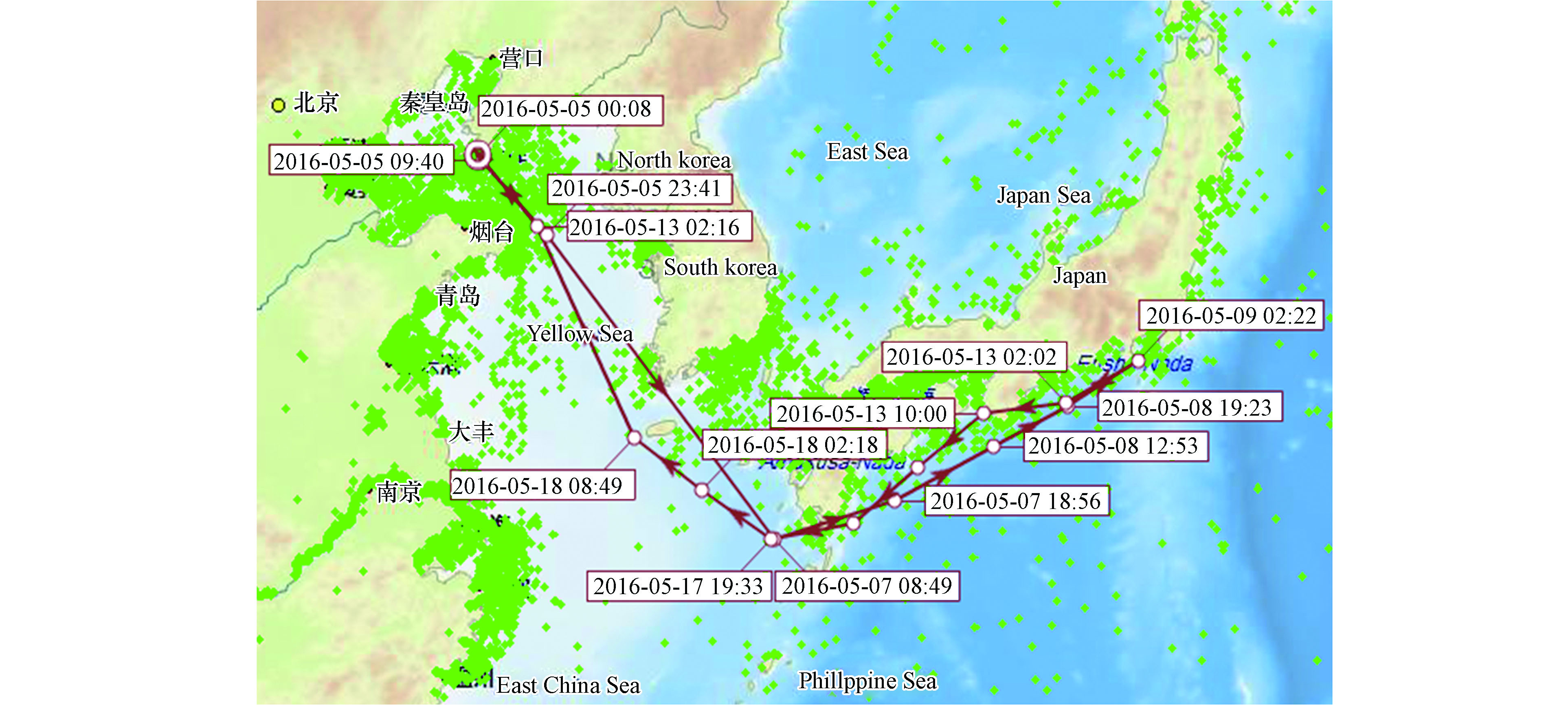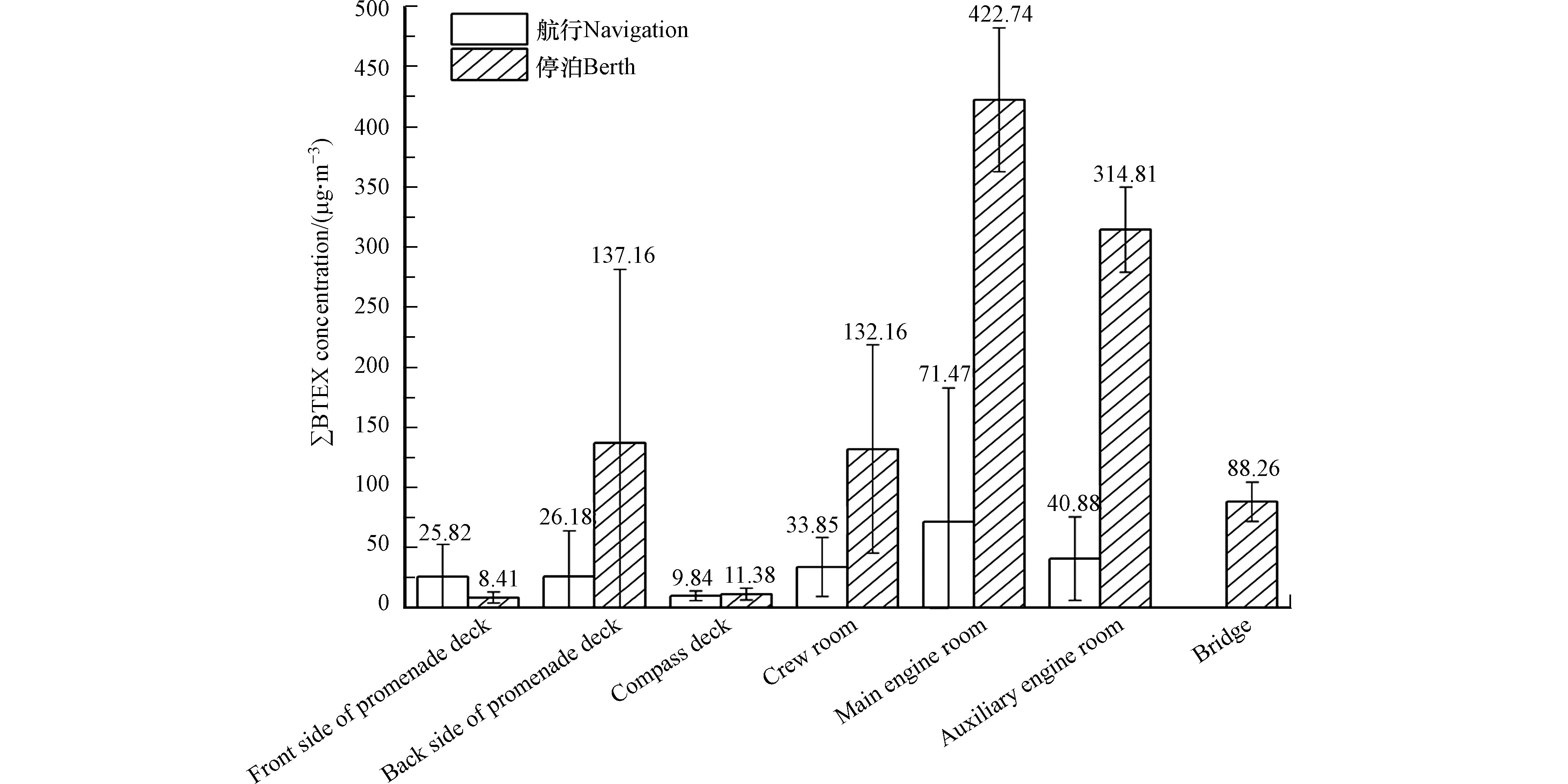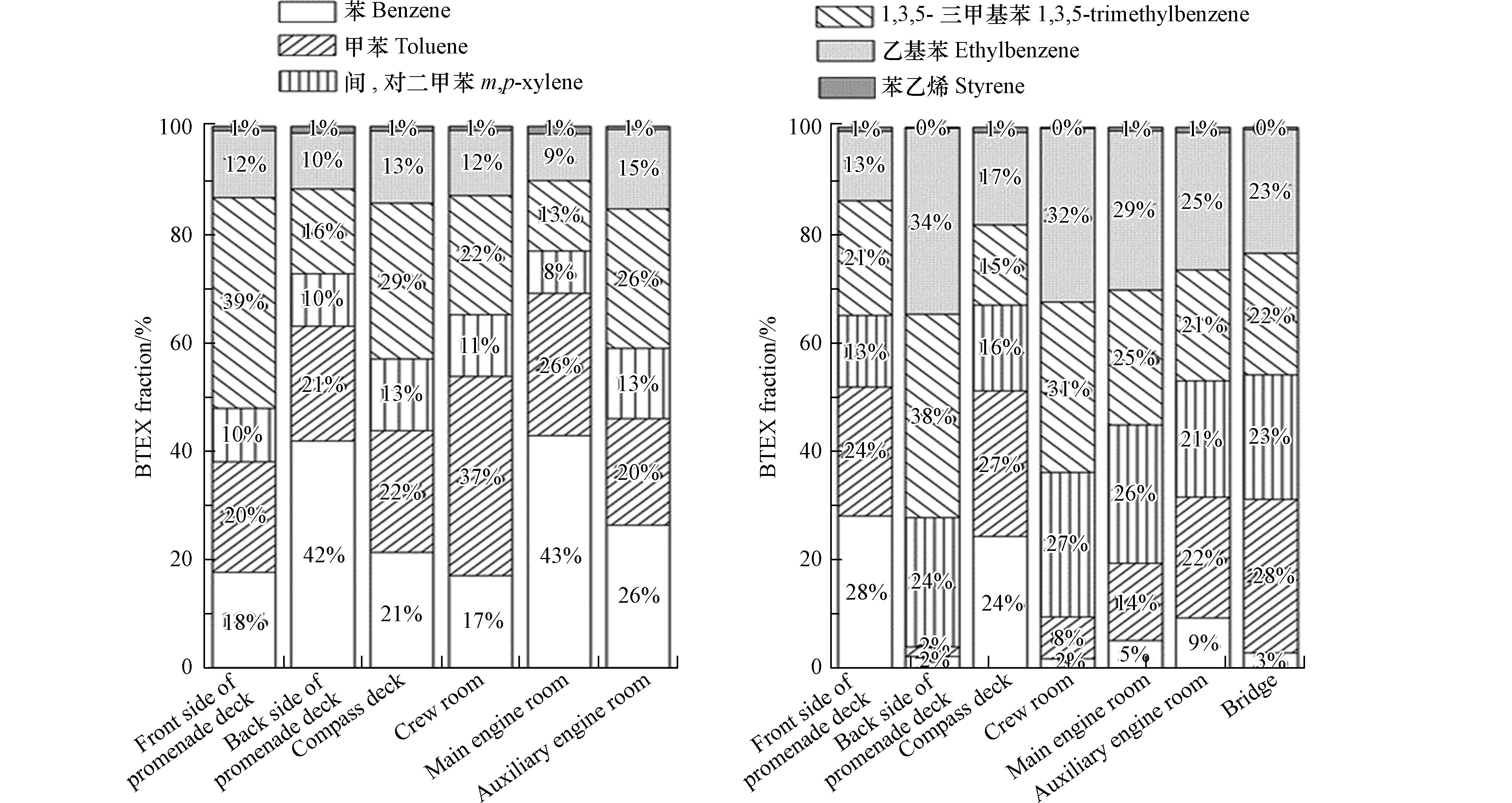-
公众日益关注交通运输和建筑物中的室内空气质量。研究报道,乘坐私家车、公共汽车、地铁和飞机的人群可能暴露在更高的污染物浓度下[1-4]。由于船舶不如其他运输方式普及,其舱室内空气污染水平的研究也较少[5]。然而,研究表明船员健康风险相对较高[6],舱室内的工作环境对船员身体健康的影响不容忽视[7]。舰艇封闭舱室环境中污染源众多,如人体代谢产物产生的氨、甲酸、尿酸、醛、甲硫醇、挥发性胺等有害物质; 烹饪产生的大量丙烯醛、含氧化合物和气溶胶等; 非金属材料如油漆、塑料、橡胶、燃料、润滑油、粘合剂等产生的大量烷烃、烯烃、卤代烃、芳香烃、含氧化合物、含硫化合物、气溶胶等多种有害物质[8]。挥发性有机化合物(volatile organic compounds, VOCs),作为舱室内重要的污染物[9],在室温下很容易蒸发,并通过呼吸途径进入到人体内[10-12]。美国环保署将苯系物列为优先控制的污染物。此外,长期暴露于环境空气中的苯系物下不仅会刺激人体皮肤和粘膜[13],还会引起呼吸系统,造血系统和神经系统的慢性和急性病变[14-16]。国际癌症研究机构(IARC)已证实,苯是一类致癌物质,长期暴露在高浓度苯的环境空气中会增加人类患癌症的风险,并可能导致白血病和淋巴疾病[17-20]。
空气中的苯系物可通过主动或被动采样器采集。被动空气采样器使用的吸附剂包括浸渍聚氨酯泡沫(SIP)[21-22]、聚氨酯泡沫(PUF)[23]、聚苯乙烯-二乙烯基苯共聚树脂(XAD)[24]和Tenax[25-26]。相比于主动采样,被动采样不需要外接电源,可以灵活设置采样地点,适合各类现场监测,另外主动采样器的气泵会造成噪声污染[27]。被动采样周期可长达数个月,并且不存在样品穿透等问题[27]。近年来已有研究使用TD管作为被动采样器来采集空气中VOCs[28]。其优点是样品制备不需要溶剂萃取,可直接在气相色谱上机检测,从而降低了中间程序导致样品污染的风险[27]。
方晶晶等[8]使用Tedlar采气袋在舰艇舱室封闭环境中检测了27种VOCs。张锦岚等[29]使用主动采样方法通过Tenax-TA采样管对舰船舱室内以苯、甲苯、乙基苯和二甲苯(BTEX)为代表的 VOCs 释放速率进行研究。Kim等[5]使用主动采样方法(Tenax-TA)监测了两艘新船舱室中VOCs浓度。本研究使用被动采样方法,即通过内含Tenax-TA吸附剂的TD管采集了某实习船舱室内外空气中苯系物样品,分析了样品浓度水平、组分特征,并评估了苯系物对船员的潜在健康风险,可为舱室空气污染治理提供理论依据。
全文HTML
-
材料:苯系物标准溶液(2000 μg·mL−1)购自上海安谱实验科技股份有限公司;甲醇(纯度> 99.9%)购自美国Sigma-Aldrich公司。TD管购自英国玛珂思公司(Marks, UK),内含吸附剂Tenax TA 60/80(200 mg),TD管长度为89 mm,外径为6.5 mm,内径为5.0 mm(图1)。
仪器:热脱附老化仪(TC-20, Marks, UK), 热脱附进样器(UNITY2, Marks, UK)和气相色谱-质谱联用仪(7890A-5975C, Agilent Technologies, USA)。
-
在某实习船出访活动期间(2016.4.17—5.19),利用TD管采集了船舶舱室外游步甲板前侧、游步甲板后侧和罗经甲板及舱室内驾驶台、主机舱、辅机舱和船员室的空气样品,共采集了54个样品。TD管一端为黄铜帽,另一端为扩散帽(采样端),将TD管固定放置在距地面高度1.5—2.0 m处,采样端朝下,并远离门窗,采样结束时,TD管采样端用黄铜帽拧紧并放置在铝箔袋中封存,保存在4 ℃的冰箱中,船舶航迹(http://www.shipxy.com/)见图2,采样信息详见表1。
-
热脱附条件:氦气为载气,将TD管安装到热脱附进样器上,以20 mL·min−1的速率吹扫1 min。初级解析10 min,解析温度300 ℃,冷阱温度10 ℃,氦气流速30 mL·min−1;二级解析3 min,冷阱温度310 ℃,氦气流速20 mL·min−1,分流比为5∶1。
气相色谱条件:选用DB-VRX毛细管柱(60 m ×0.25 mm,1.4 m),进样口温度为200 ℃,不分流模式,进样速率1.0 mL·min−1。柱箱升温程序从40 ℃开始,保持10 min,然后以10 ℃·min−1升到190 ℃保持2 min,然后以6 ℃·min−1升到225 ℃保持3 min。
质谱条件:离子源温度230 ℃,四极杆温度150 ℃,采用电子撞击电离选择离子模式(SIM)进行定量,溶剂延迟时间9.5 min。
将标准品稀释至6个浓度梯度(0.08 μg·mL−1至25 μg·mL−1之间)进行曲线校正。根据色谱图的积分面积,计算出各苯系物的校正函数。
样品浓度:
式中,C,样品浓度(μg·m−3);m,校准曲线中苯系物质量(μg);R,苯系物被动采样吸收速率(mL·min−1)[27, 30];t,采样时间(min)。
-
TD管在采样前使用热脱附管老化仪(TC-20, Marks, UK)在335 ℃下老化30 min,载气为高纯氮气(99.999%),流速为90 mL·min−1。老化结束后TD管两端用黄铜帽密封,并保存在4 ℃的冰箱备用。在样品采集、处理、测试过程中,实验员全程佩戴橡胶手套以免污染样品。每批样品测试前分别设置样品空白和溶剂空白,以检查背景污染。每批现场空白样品中会检测到的个别目标化合物,但其含量均低于相应样品含量的10%。最终浓度为测量值减去现场空白值。目标物的方法检出限(LOD)和方法定量限(LOQ)分别通过多次测量低浓度标准溶液的3倍和10倍信噪比(S/N)计算得到(表2)[31],本研究各个苯系物的LOD为0.18 μg ·L−1至1.37 μg ·L−1,LOQ为0.60 μg ·L−1至4.58 μg·L−1。
-
健康风险评估方法为EPA-540-R-070-002(USEPA 2009)[32]。
(1) 非致癌风险:
慢性和亚慢性暴露浓度(EC):
非致癌风险危险商值(HQ):
危害指数(HI):
(2) 致癌风险
式中,CA为暴露浓度(μg·m−3);ET为暴露浓度时间(h·d−1);EF为暴露频率(d·a−1);ED为暴露工龄(a),本研究取30年;AT为平均时间(h):非致癌风险中取值为ED×365 d·a−1×24 h·d−1,致癌风险中取值为期望寿命(70 a)×365 d·a−1×24 h·d−1;RfC(参考浓度)值取自US EPA综合风险信息系统 (IRIS)[33]; 苯的毒性值(IUR)最大值为6×10−6 μg·m−3,取自WHO[34]。乙苯IUR值为2.5×10−6 μg·m−3,取自加州环境保护局环境健康危害评估办公室(OEHHA)[35]。HI的阈值为1.0,HI>1表明环境浓度具有显著的非致癌效应[36-37]。当Risk≥1×10−6时,认为污染物对人体有致癌风险[38-39]。
1.1. 材料与仪器
1.2. 样品采集
1.3. 样品分析
1.4. 质量保证和质量控制(QA/QC)
1.5. 健康风险评估
-
航行期间:各监测点位的浓度水平(μg·m−3)为主机舱(71.47)>辅机舱(40.88)>船员室(33.85)>游步甲板后侧(26.18)>游步甲板前侧(25.82)>罗经甲板(9.84)(图3和表3)。辅机舱的主要组分为1,3,5-三甲基苯(26%)和苯(26%),其次为甲苯(20%);主机舱的主要组分为苯(43%),其次为甲苯(26%)和1,3,5-三甲基苯(13%);船员室、游步甲板前侧、游步甲板后侧及罗经甲板的主要组分为苯、甲苯及1,3,5-三甲基苯,占比之和均>72%;苯乙烯在所有监测点位中占比均低于1%(见图4)。
停泊期间:各监测点位浓度水平(μg·m−3)为主机舱(422.74)>辅机舱(314.81)>游步甲板后侧(137.16)>船员室(132.16)>驾驶台(88.26)>罗经甲板(11.38)>游步甲板前侧(8.41)。游步甲板前侧和罗经甲板主要组分均为甲苯及苯,占比之和大于51%。游步甲板后侧和船员室中主要组分为乙基苯、1,3,5-三甲基苯和间,对二甲苯,三者占比之和均>90%。主机舱、辅机舱及驾驶台中主要组分为甲苯、间,对二甲苯、乙基苯和1,3,5-三甲基苯,其占比之和>90%。
停泊期间各监测点位(除驾驶台外)苯系物总浓度水平 (1026.66 μg·m−3)为航行期间(208.04 μg·m−3)的5倍。其中,停泊期间游步甲板后侧、罗经甲板、船员室、主机舱、辅机舱的浓度水平分别是航行期间的5.24、1.16、3.90、5.91、7.70倍。在航行与停泊期间,主机舱和辅机舱的浓度处于较高水平,航行均大于40.88 μg·m−3,停泊均大于314.81 μg·m−3,而游步甲板前侧和罗经甲板处于较低水平,均小于25.82 μg·m−3。在航行期间,游步甲板后侧及船员室中苯和甲苯的占比之和高于54%,主机舱中苯和甲苯占比之和高于69%,辅机舱中苯和1,3,5-三甲基苯的占比之和高于52%,游步甲板前侧及罗经甲板的主要组分为1,3,5-三甲基苯和甲苯,占比之和均大于51%;停泊期间,游步甲板后侧及船员室中乙基苯和1,3,5-三甲基苯占比之和高于63%;主机舱及辅机舱中乙基苯占比均最高,分别为29%及25%,游步甲板前侧及罗经甲板的主要组分为苯和甲苯,占比之和均大于51%。
在航行与停泊期间,船员室、主机舱、辅机舱和驾驶台空气中苯、甲苯和二甲苯的平均浓度均低于室内空气质量标准的限值 (GB/T 18883-2002) (表4);苯和甲苯均低于舰船污染物的容许浓度(表5)。本研究中间,对二甲苯、乙基苯的浓度均低于Kim等[5]报道的新建游客船及新建货船主机舱的浓度;间,对二甲苯分别比其低1.91倍,89.89倍;乙基苯分别比其低3.38倍,8.35倍;甲苯比货船高1.13倍,比游客船低1.33倍。苯,甲苯,间,对-二甲苯,乙基苯的浓度均低于张锦岚等[29]报道的舱室通风24 h后的浓度。与其他工业和非工业环境室内空气中苯系物的指导值相比,在停泊和航行期间,船舶舱室内空气中苯系物的平均浓度均低于世界卫生组织(WHO)、美国职业安全与健康标准(OSHA)、美国政府和工业卫生委员会(ACGIH)和加州环境健康危害评估办公室(OEHHA)建议的限值。
-
本研究中,船舶健康风险评估对象包括以船长、大副、二副、三副和水手等为代表的甲板部船员,以轮机长、大管轮、二管轮、三管轮和电机员为代表的轮机部船员。船员在船时间包括航行及停泊期间,实习船的航行时间约为76 d·a−1,停泊时间约为189 d·a−1[42]。甲板部和轮机部船员值班时间见表6。甲板部船员:职业环境苯系物暴露浓度范围为3.66—71.73 μg·m−3;其中,停泊期间船员室苯系物的暴露浓度最高,为71.33 μg·m−3;航行期间船员室苯系物的暴露浓度最低,为3.66 μg·m−3。轮机部船员:职业环境苯系物暴露浓度范围为2.11—47.82 μg·m−3;其中,停泊期间船员室苯系物的暴露浓度最高,为47.82 μg·m−3;航行期间辅机舱苯系物的暴露浓度最低,为2.11 μg·m−3 (表6)。
-
甲板部船员:船舶职业环境中苯系物的HI范围为0.02—0.38,在船舶停泊期间船员室HI值最高(0.38)。轮机部船员:船舶职业环境中苯系物的HI范围为0.03—0.26,在船舶停泊期间主机舱HI值最高(0.26)。轮机部船员职业环境中苯系物的HI值(0.84)高于甲板部船员(0.43)。苯系物非致癌风险:轮机部船员>甲板部船员。监测期间船舶职业环境中各苯系物的HQ值均低于阈值1.0。因此,船舶职业环境中的苯系物对甲板部船员和轮机部船员不存在显著的非致癌风险,见表7。甲板部船员:航行期间驾驶台乙基苯的致癌风险值为1.5×10−6;船员室苯的致癌风险值为2.06×10−6,停泊期间船员室苯及乙基苯分别为6.42×10−6和3.6×10−5,均高于US EPA推荐的限制标准(1.0×10−6)。轮机部船员:航行期间船员室、辅机舱及主机舱苯的致癌风险值分别为2.06×10−6、1.92×10−6和2.74×10−6;停泊期间主机舱苯及乙基苯分别为7.49×10−6和1.76×10−5;辅机舱苯及乙基苯分别为1×10−5和1.13×10−5;船员室苯及乙基苯分别为3.29×10−6和2.40×10−5,均高于US EPA推荐的限制标准。以上分析表明,甲板部船员与轮机部船员职业环境中的苯和乙基苯均存在潜在的致癌风险,致癌风险值见表8。
2.1. 苯系物浓度水平
2.2. 暴露评估
2.3. 健康风险评估
-
航行期间,主机舱的苯系物平均浓度水平最高,主要组分为苯和甲苯,二者占比之和为69%。停泊期间,主机舱苯系物平均浓度水平最高,主要组分为乙基苯(29%)。停泊期间各监测点位(除驾驶台外)苯系物总浓度水平为航行期间的5倍。船员职业环境中相应苯系物的平均浓度均低于室内空气质量标准限值、舰船污染物的容许浓度、国际组织机构所推荐的工业和非工业环境室内空气中苯系物的指导值,目前还没有关于船舶职业环境空气质量的国际标准。船员职业环境中的苯、甲苯、间,对二甲苯、乙基苯和苯乙烯对甲板部和轮机部船员不存在显著的非致癌风险,而甲板部船员与轮机部船员职业环境中的苯和乙基苯均存在潜在的致癌风险。
本研究中,由于航行期间驾驶台浓度数据缺失,在健康风险评估时采用停泊期间数据,因此甲板部船员职业环境中危险商值和风险值可能会被高估。与实习船相比,商船实际航行时间远高于实习船,而停泊时间远低于实习船,因此商船船员职业环境中危险商值和风险值会远低于实习船。此外,随着限硫令(0.5%)的实施,新型船用燃料油的使用将会改变船舶舱室空气苯系物的浓度水平和组分特征,因此,对船员职业健康风险的影响有待进一步研究。




 下载:
下载:




